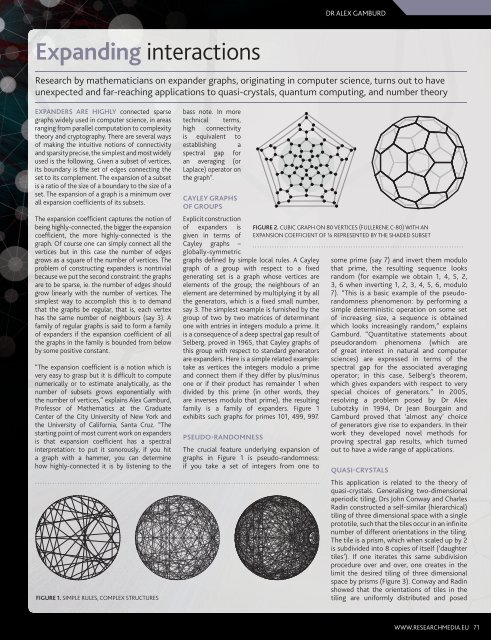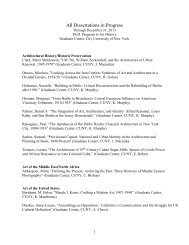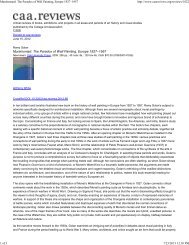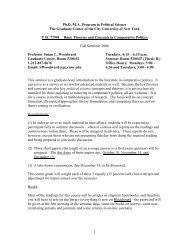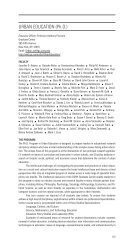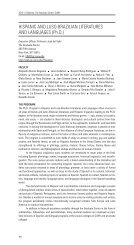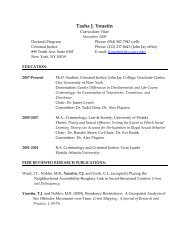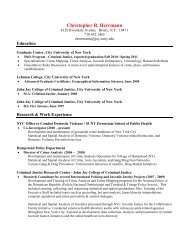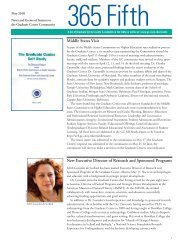Mathematical marvels - CUNY Graduate Center
Mathematical marvels - CUNY Graduate Center
Mathematical marvels - CUNY Graduate Center
Create successful ePaper yourself
Turn your PDF publications into a flip-book with our unique Google optimized e-Paper software.
Expanding interactions<br />
EXPANDERS ARE HIGHLY connected sparse<br />
graphs widely used in computer science, in areas<br />
ranging from parallel computation to complexity<br />
theory and cryptography. There are several ways<br />
of making the intuitive notions of connectivity<br />
and sparsity precise, the simplest and most widely<br />
used is the following. Given a subset of vertices,<br />
its boundary is the set of edges connecting the<br />
set to its complement. The expansion of a subset<br />
is a ratio of the size of a boundary to the size of a<br />
set. The expansion of a graph is a minimum over<br />
all expansion coeffi cients of its subsets.<br />
The expansion coeffi cient captures the notion of<br />
being highly-connected, the bigger the expansion<br />
coeffi cient, the more highly-connected is the<br />
graph. Of course one can simply connect all the<br />
vertices but in this case the number of edges<br />
grows as a square of the number of vertices. The<br />
problem of constructing expanders is nontrivial<br />
because we put the second constraint: the graphs<br />
are to be sparse, ie. the number of edges should<br />
grow linearly with the number of vertices. The<br />
simplest way to accomplish this is to demand<br />
that the graphs be regular, that is, each vertex<br />
has the same number of neighbours (say 3). A<br />
family of regular graphs is said to form a family<br />
of expanders if the expansion coeffi cient of all<br />
the graphs in the family is bounded from below<br />
by some positive constant.<br />
“The expansion coeffi cient is a notion which is<br />
very easy to grasp but it is diffi cult to compute<br />
numerically or to estimate analytically, as the<br />
number of subsets grows exponentially with<br />
the number of vertices,” explains Alex Gamburd,<br />
Professor of Mathematics at the <strong>Graduate</strong><br />
<strong>Center</strong> of the City University of New York and<br />
the University of California, Santa Cruz. “The<br />
starting point of most current work on expanders<br />
is that expansion coeffi cient has a spectral<br />
interpretation: to put it sonorously, if you hit<br />
a graph with a hammer, you can determine<br />
how highly-connected it is by listening to the<br />
bass note. In more<br />
technical terms,<br />
high connectivity<br />
is equivalent to<br />
establishing a<br />
spectral gap for<br />
an averaging (or<br />
Laplace) operator on<br />
the graph”.<br />
CAYLEY GRAPHS<br />
OF GROUPS<br />
Explicit construction<br />
of expanders is<br />
given in terms of<br />
Cayley graphs –<br />
globally-symmetric<br />
graphs defi ned by simple local rules. A Cayley<br />
graph of a group with respect to a fi xed<br />
generating set is a graph whose vertices are<br />
elements of the group; the neighbours of an<br />
element are determined by multiplying it by all<br />
the generators, which is a fi xed small number,<br />
say 3. The simplest example is furnished by the<br />
group of two by two matrices of determinant<br />
one with entries in integers modulo a prime. It<br />
is a consequence of a deep spectral gap result of<br />
Selberg, proved in 1965, that Cayley graphs of<br />
this group with respect to standard generators<br />
are expanders. Here is a simple related example:<br />
take as vertices the integers modulo a prime<br />
and connect them if they differ by plus/minus<br />
one or if their product has remainder 1 when<br />
divided by this prime (in other words, they<br />
are inverses modulo that prime), the resulting<br />
family is a family of expanders. Figure 1<br />
exhibits such graphs for primes 101, 499, 997.<br />
PSEUDO-RANDOMNESS<br />
The crucial feature underlying expansion of<br />
graphs in Figure 1 is pseudo-randomness:<br />
if you take a set of integers from one to<br />
DR ALEX GAMBURD<br />
Research by mathematicians on expander graphs, originating in computer science, turns out to have<br />
unexpected and far-reaching applications to quasi-crystals, quantum computing, and number theory<br />
FIGURE 1. SIMPLE RULES, COMPLEX STRUCTURES<br />
FIGURE 2. CUBIC GRAPH ON 80 VERTICES (FULLERENE C-80) WITH AN<br />
EXPANSION COEFFICIENT OF ¼ REPRESENTED BY THE SHADED SUBSET<br />
some prime (say 7) and invert them modulo<br />
that prime, the resulting sequence looks<br />
random (for example we obtain 1, 4, 5, 2,<br />
3, 6 when inverting 1, 2, 3, 4, 5, 6, modulo<br />
7). “This is a basic example of the pseudorandomness<br />
phenomenon: by performing a<br />
simple deterministic operation on some set<br />
of increasing size, a sequence is obtained<br />
which looks increasingly random,” explains<br />
Gamburd. “Quantitative statements about<br />
pseudorandom phenomena (which are<br />
of great interest in natural and computer<br />
sciences) are expressed in terms of the<br />
spectral gap for the associated averaging<br />
operator; in this case, Selberg’s theorem,<br />
which gives expanders with respect to very<br />
special choices of generators.” In 2005,<br />
resolving a problem posed by Dr Alex<br />
Lubotzky in 1994, Dr Jean Bourgain and<br />
Gamburd proved that ‘almost any’ choice<br />
of generators give rise to expanders. In their<br />
work they developed novel methods for<br />
proving spectral gap results, which turned<br />
out to have a wide range of applications.<br />
QUASI-CRYSTALS<br />
This application is related to the theory of<br />
quasi-crystals. Generalising two-dimensional<br />
aperiodic tiling, Drs John Conway and Charles<br />
Radin constructed a self-similar (hierarchical)<br />
tiling of three dimensional space with a single<br />
prototile, such that the tiles occur in an infi nite<br />
number of different orientations in the tiling.<br />
The tile is a prism, which when scaled up by 2<br />
is subdivided into 8 copies of itself (‘daughter<br />
tiles’). If one iterates this same subdivision<br />
procedure over and over, one creates in the<br />
limit the desired tiling of three dimensional<br />
space by prisms (Figure 3). Conway and Radin<br />
showed that the orientations of tiles in the<br />
tiling are uniformly distributed and posed<br />
WWW.RESEARCHMEDIA.EU 71


